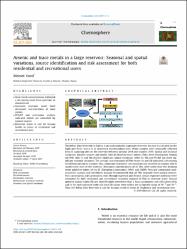| dc.contributor.author | Varol, Memet | |
| dc.date.accessioned | 2021-06-15T20:59:40Z | |
| dc.date.available | 2021-06-15T20:59:40Z | |
| dc.date.issued | 2019 | en_US |
| dc.identifier.citation | Varol, M. (2019). Arsenic and trace metals in a large reservoir: Seasonal and spatial variations, source identification and risk assessment for both residential and recreational users. Chemosphere, 228, 1-8. | en_US |
| dc.identifier.issn | 0045-6535 | en_US |
| dc.identifier.issn | 1879-1298 | en_US |
| dc.identifier.uri | https://doi.org/10.1016/j.chemosphere.2019.04.126 | |
| dc.identifier.uri | https://hdl.handle.net/20.500.12899/260 | |
| dc.description.abstract | The Keban Dam Reservoir in Turkey is an internationally important reservoir, because it is located on the Euphrates River, which is an important transboundary river. Water samples were seasonally collected from 11 sampling sites on the reservoir between autumn 2014 and summer 2015. Spatial and seasonal variations, possible sources and health risks of dissolved trace metals (TMs) were investigated. Among ten TMs, only Cr and Mn showed significant spatial variations, while Cr, Mn and Pb did not show significant seasonal variations. The average concentrations of TMs except As and Cd indicated a decreasing trend from autumn to summer. Also, minimum total metal concentration was recorded in summer due to raised water level of the reservoir. Maximum concentrations of all TMs were lower than the drinking water guideline values set by EC (European Community), WHO and USEPA. Principle component analysis/factor analysis and correlation analysis demonstrated that all TMs originate from natural sources. Non-carcinogenic and carcinogenic risks through ingestion and dermal contact exposure pathways were estimated for both residential and recreational receptors exposed to TMs in reservoir water. Hazard quotient, hazard index (HI) and total HI values were lower than 1. Also, carcinogenic risk (CR) values of As and Cr for each exposure route and total CR values were within the acceptable range of 10(-4) and 10(-6). Thus, the Keban Dam Reservoir is safe for human health in terms of residential and recreational uses. (C) 2019 Elsevier Ltd. All rights reserved. | en_US |
| dc.language.iso | en | en_US |
| dc.publisher | Elsevier | en_US |
| dc.relation.ispartof | Chemosphere | en_US |
| dc.rights | info:eu-repo/semantics/closedAccess | en_US |
| dc.subject | Risk assessment | en_US |
| dc.subject | Dissolved metals | en_US |
| dc.subject | Freshwater reservoir | en_US |
| dc.subject | Multivariate statistical methods | en_US |
| dc.subject | Seasonal and spatial variations | en_US |
| dc.title | Arsenic and trace metals in a large reservoir: Seasonal and spatial variations, source identification and risk assessment for both residential and recreational users | en_US |
| dc.type | Article | en_US |
| dc.authorid | 0000-0001-6475-0570 | en_US |
| dc.department | MTÖ Üniversitesi, Doğanşehir Vahap Küçük Meslek Yüksekokulu, Su Ürünleri Bölümü | en_US |
| dc.institutionauthor | Varol, Memet | |
| dc.identifier.doi | 10.1016/j.chemosphere.2019.04.126 | |
| dc.identifier.volume | 28 | en_US |
| dc.identifier.startpage | 1 | en_US |
| dc.identifier.endpage | 8 | en_US |
| dc.relation.publicationcategory | Makale - Uluslararası Hakemli Dergi - Kurum Öğretim Elemanı | en_US |
| dc.identifier.pmid | 31015038 | |
| dc.identifier.scopus | 2-s2.0-85064815993 | en_US |
| dc.identifier.scopusquality | Q1 | en_US |
| dc.identifier.wos | WOS:000471084700001 | en_US |
| dc.identifier.wosquality | Q1 | en_US |
| dc.indekslendigikaynak | Web of Science | en_US |
| dc.indekslendigikaynak | Scopus | en_US |
| dc.indekslendigikaynak | PubMed | en_US |


















